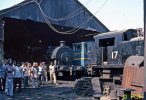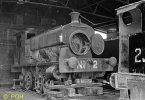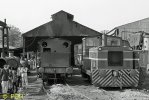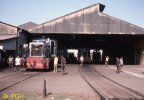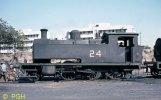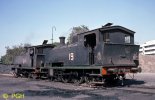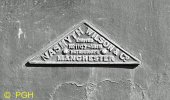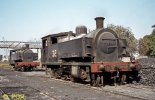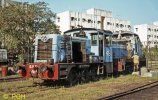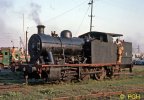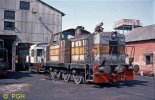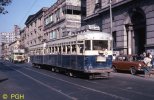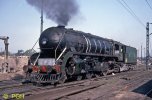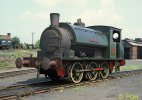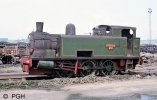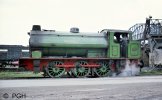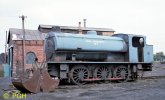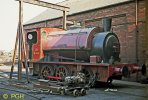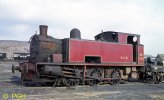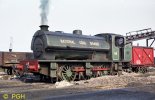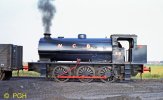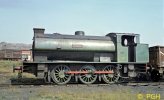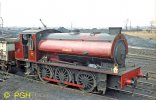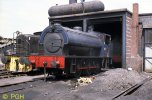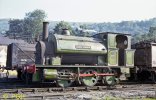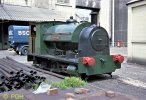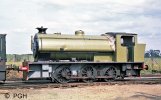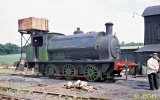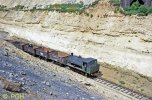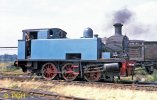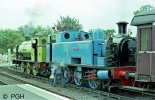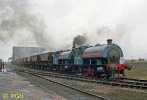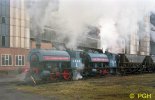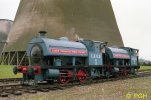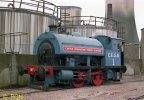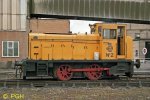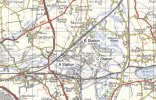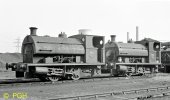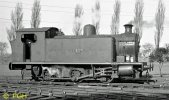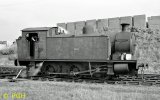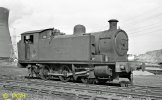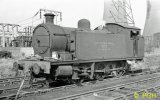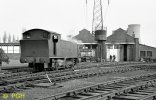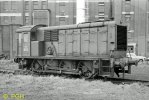You are using an out of date browser. It may not display this or other websites correctly.
You should upgrade or use an alternative browser.
You should upgrade or use an alternative browser.
Prototype PhilH's Industrial Railway Photos
- Thread starter PhilH
- Start date
PhilH
Western Thunderer
In contrast to the last location (TISCO a few posts back), most of the locomotives at the Indian Iron & Steel Company's Kulti Works would seem quite at home on any UK industrial system, except of course for the 5'-6" gauge.
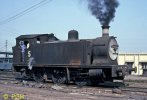
No. 5 built by Hawthorn Leslie of Newcastle in 1924.
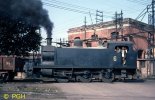
No. 6 also built by Hawthorn Leslie in 1927.
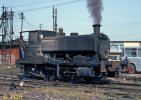
No.7 an Andrew Barclay of 1937.
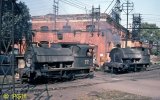
Nos.22 and 26, two of a batch of 7 similar locos all built in 1943 by Robert Stephenson & Hawthorns.
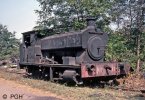
No.1H built by Andrew Barclay in 1920, withdrawn and presumably awaiting scrapping.
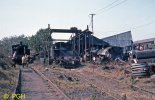
The loco shed area, with a stack of wheel tyres on the right in front of a couple of Andrew Barclay saddle tanks. Beyond are a blue Suri & Nayar (SAN Engineering & Locomotive Co. Ltd., of Bangalore) 4 wheel diesel hydraulic and No.27 another of the 1943 RSH 0-4-0STs on the loco shed roads. In the centre is the chassis of No.6 an Andrew Barclay 0-4-0ST of 1927 which had a broken axle, and behind and to the left are two Nasmyth Wilson 2-6-0Ts originally built in 1914 for the Bombay Port Trust.
Start taking photographs and you soon draw a crowd ! Peeping out of the gloom of the loco shed is No.23 another of the 1943 RSH 0-4-0STs and to the right No.17 a RSH 0-6-0T built in 1948.
Rear view of RSH 0-4-0ST No.27 with the unnumbered SAN 4wDH built in 1976. Note the difference in width of the two locos - the RSH, one of the standard builders designs for 4'-8½" gauge adapted to 5'-6" gauge, and the diesel designed for 5'-6" gauge. Behind the diesel is another SAN 4wDH loco numbered 3 built in 1978 and facing the other way.

No. 5 built by Hawthorn Leslie of Newcastle in 1924.

No. 6 also built by Hawthorn Leslie in 1927.

No.7 an Andrew Barclay of 1937.

Nos.22 and 26, two of a batch of 7 similar locos all built in 1943 by Robert Stephenson & Hawthorns.

No.1H built by Andrew Barclay in 1920, withdrawn and presumably awaiting scrapping.

The loco shed area, with a stack of wheel tyres on the right in front of a couple of Andrew Barclay saddle tanks. Beyond are a blue Suri & Nayar (SAN Engineering & Locomotive Co. Ltd., of Bangalore) 4 wheel diesel hydraulic and No.27 another of the 1943 RSH 0-4-0STs on the loco shed roads. In the centre is the chassis of No.6 an Andrew Barclay 0-4-0ST of 1927 which had a broken axle, and behind and to the left are two Nasmyth Wilson 2-6-0Ts originally built in 1914 for the Bombay Port Trust.
Start taking photographs and you soon draw a crowd ! Peeping out of the gloom of the loco shed is No.23 another of the 1943 RSH 0-4-0STs and to the right No.17 a RSH 0-6-0T built in 1948.
Rear view of RSH 0-4-0ST No.27 with the unnumbered SAN 4wDH built in 1976. Note the difference in width of the two locos - the RSH, one of the standard builders designs for 4'-8½" gauge adapted to 5'-6" gauge, and the diesel designed for 5'-6" gauge. Behind the diesel is another SAN 4wDH loco numbered 3 built in 1978 and facing the other way.
PhilH
Western Thunderer
I visited the Bombay Docks System controlled by the Bombay Port Trust on two occasions, in March 1976 and December 1979.
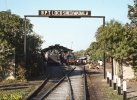
The entrance to the steam shed at Wadala, a suburb of Bombay (as it was then - now Mumbai of course)
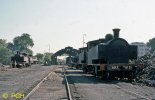
View of the shed yard looking back towards the entrance. The rather basic loco shed seems to have been mainly used for repairs with most of the locos stabled outside.
The diesels had a larger 3 road shed - with plenty of staff standing round or wandering about ! No.44 is one of the three Canadian built 0-4-4-0 diesel hydraulics.
The steam loco stock comprised 2-6-0 side tanks, an uncommon wheel arrangement for industrial locos. A total of 30 were supplied new to the BPT, 24 built by Nasmyth Wilson in four batches between 1913 and 1921, and a further 6 built by Vulcan Foundry in 1922. By the late 1970s the total was down to 18, with the older ones either sold for industrial use or scrapped. Nasmyth Wilson also supplied two massive 106 ton 2-10-2T locos in 1922, but these had been scrapped shortly before the 1976 visit.
The distinctive triangular works plate fitted by Nasmyth Wilson to its locomotives after 1906. Just to confuse historians this is the original plate from No.10 (by then disposed of) fitted to No.16 !
The Patricroft Works of Nasmyth Wilson & Co. Ltd., known as the Bridgewater Foundry, were situated on the North side of the Liverpool & Manchester Railway adjacent to Patricroft Station and alongside the Bridgewater Canal, which passed under the L&M at that point. First established on this site in 1836, the works built a total of 1,632 locomotives between 1839 and the cessation of locomotive building in 1938. The majority were built for export with many supplied to various Indian Railways. The total is considerably less than the two other major local builders Vulcan Foundry and Beyer Peacock, with respectively 4,775 and 6,860 locomotives built up to the end of 1938. However Nasmyth Wilson also produced machine tools including the steam hammer invented by James Nasmyth. In 1940 the works were taken over by the Ministry of Supply as a Royal Ordnance Factory for the war effort. After privatisation and a spell with British Aerospace it was finally closed in 1989 and the site is now occupied by private housing and an industrial estate appropriately named the Nasmyth Business Park.
No.32 was the last steam loco supplied to the BPT, built by Vulcan Foundry and identical to the Nasmyth Wilson locos. As NW were already building 10 of these locos and the two 2‑10‑2Ts presumably they subcontracted the last six out to VF. Note that No.32 now carries a NW triangular works plate while No.15 behind, a NW built loco, carries a VF oval worksplate ! Evidently when locos were dismantled for repair they didn't worry about whether the top part of the cab, which carried the works plates, went back on the original loco.

The entrance to the steam shed at Wadala, a suburb of Bombay (as it was then - now Mumbai of course)

View of the shed yard looking back towards the entrance. The rather basic loco shed seems to have been mainly used for repairs with most of the locos stabled outside.
The diesels had a larger 3 road shed - with plenty of staff standing round or wandering about ! No.44 is one of the three Canadian built 0-4-4-0 diesel hydraulics.
The steam loco stock comprised 2-6-0 side tanks, an uncommon wheel arrangement for industrial locos. A total of 30 were supplied new to the BPT, 24 built by Nasmyth Wilson in four batches between 1913 and 1921, and a further 6 built by Vulcan Foundry in 1922. By the late 1970s the total was down to 18, with the older ones either sold for industrial use or scrapped. Nasmyth Wilson also supplied two massive 106 ton 2-10-2T locos in 1922, but these had been scrapped shortly before the 1976 visit.
The distinctive triangular works plate fitted by Nasmyth Wilson to its locomotives after 1906. Just to confuse historians this is the original plate from No.10 (by then disposed of) fitted to No.16 !
The Patricroft Works of Nasmyth Wilson & Co. Ltd., known as the Bridgewater Foundry, were situated on the North side of the Liverpool & Manchester Railway adjacent to Patricroft Station and alongside the Bridgewater Canal, which passed under the L&M at that point. First established on this site in 1836, the works built a total of 1,632 locomotives between 1839 and the cessation of locomotive building in 1938. The majority were built for export with many supplied to various Indian Railways. The total is considerably less than the two other major local builders Vulcan Foundry and Beyer Peacock, with respectively 4,775 and 6,860 locomotives built up to the end of 1938. However Nasmyth Wilson also produced machine tools including the steam hammer invented by James Nasmyth. In 1940 the works were taken over by the Ministry of Supply as a Royal Ordnance Factory for the war effort. After privatisation and a spell with British Aerospace it was finally closed in 1989 and the site is now occupied by private housing and an industrial estate appropriately named the Nasmyth Business Park.
No.32 was the last steam loco supplied to the BPT, built by Vulcan Foundry and identical to the Nasmyth Wilson locos. As NW were already building 10 of these locos and the two 2‑10‑2Ts presumably they subcontracted the last six out to VF. Note that No.32 now carries a NW triangular works plate while No.15 behind, a NW built loco, carries a VF oval worksplate ! Evidently when locos were dismantled for repair they didn't worry about whether the top part of the cab, which carried the works plates, went back on the original loco.
Last edited:
PhilH
Western Thunderer
By the late 1970s shunting within the docks was carried out by diesel locos while the steam locomotives worked in the sidings outside the dock area. No.48 was one of seven 320hp 0-6-0 diesel hydraulics supplied by the Canadian Locomotive Company of Kingston, Ontario in 1961 and No.36 behind was one of the ten 440hp 0-6-0DHs supplied by Henschel of Germany in 1957.
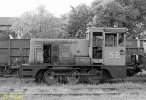
No.52 another of the Canadian 320hp 0-6-0DHs. Note the typical North American feature of a bell on the bonnet.
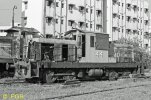
No.44 one of the three Canadian Loco Co. 640hp 0-4-4-0 diesel hydraulic locos built in 1961.
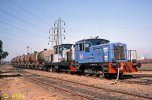
Nos.52 and 43 (with rather faded paintwork) on a train of oil tank wagons.
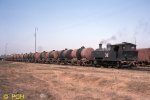
No.32 on a similar train.
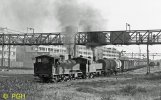
After the demise of the two 2-10-2T locos their duties were performed by the 2-6-0Ts working in pairs, as here with Nos.16 and 19.
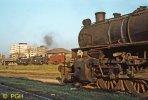
Nos.16 and 19 with Indian Railways Class CWD 2-8-2 No.12427 built in Canada.
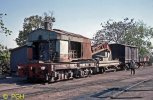
The Bombay Port Trust breakdown crane.
PhilH
Western Thunderer
Rohtas Industries Ltd. had several factories at Dehri-on-Sone in Bihar, including a sugar mill, two cement works, a paper works, a chemical works and a soap works.
To shunt this complex they had seven 5'-6" gauge locos - a small Kerr Stuart 0-4-0ST, four Jung 0-6-0Ts and two ex East Indian Railway 0-6-2Ts.
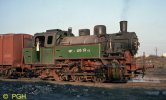
The last character in Hindi Script on the tank side denotes that this is No.4 built by Jung in Germany, works No.12796 of 1957.
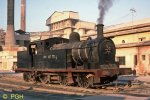
This is No.6 ex East Indian Railway CT Class built by Vulcan Foundry of Newton-le-Willows in 1908. Both these locos were working at the cement works.
From 1945 the Calcutta Port Commissioners began to replace its ageing fleet of 0-4-0 and 0-6-0 saddle tanks with new 0-6-2T locos of more modern design, a total of 45 being acquired by 1956. The first 12 were built by Hunslet in Leeds between 1945 and 1950; the next 6 by Henschel of Germany in 1950; then another batch of 6 by Hunslet in 1951; and finally the last 21 by Mitsubishi of Japan in 1955-56.
No.9 is Hunslet 3673 of 1949 shown working in 1976. By 1980 the total was down to 33, with 17 working, 5 under repair and 11 out of use either spare or withdrawn.
In 1980 there were 29 diesel locos at Calcutta Docks. Outside the diesel loco shed and workshops are D71 a 700hp 0-6-0DH built by the Chittaranjan Locomotive Works in West Bengal and D49 a 320hp 0-6-0DH built by the Canadian Locomotive Company.
Wandering off topic but still in Calcutta - a typical and rather tatty Calcutta tram in contrast to the nice and clean Hindustan Ambassador (ex Morris Oxford) on the right.
I might do more Indian steam (in another topic) if there's any interest. There was still plenty about in 1976/80 and it wasn't phased out on the main lines until the early 1990s.
To shunt this complex they had seven 5'-6" gauge locos - a small Kerr Stuart 0-4-0ST, four Jung 0-6-0Ts and two ex East Indian Railway 0-6-2Ts.

The last character in Hindi Script on the tank side denotes that this is No.4 built by Jung in Germany, works No.12796 of 1957.

This is No.6 ex East Indian Railway CT Class built by Vulcan Foundry of Newton-le-Willows in 1908. Both these locos were working at the cement works.
From 1945 the Calcutta Port Commissioners began to replace its ageing fleet of 0-4-0 and 0-6-0 saddle tanks with new 0-6-2T locos of more modern design, a total of 45 being acquired by 1956. The first 12 were built by Hunslet in Leeds between 1945 and 1950; the next 6 by Henschel of Germany in 1950; then another batch of 6 by Hunslet in 1951; and finally the last 21 by Mitsubishi of Japan in 1955-56.
No.9 is Hunslet 3673 of 1949 shown working in 1976. By 1980 the total was down to 33, with 17 working, 5 under repair and 11 out of use either spare or withdrawn.
In 1980 there were 29 diesel locos at Calcutta Docks. Outside the diesel loco shed and workshops are D71 a 700hp 0-6-0DH built by the Chittaranjan Locomotive Works in West Bengal and D49 a 320hp 0-6-0DH built by the Canadian Locomotive Company.
Wandering off topic but still in Calcutta - a typical and rather tatty Calcutta tram in contrast to the nice and clean Hindustan Ambassador (ex Morris Oxford) on the right.
I might do more Indian steam (in another topic) if there's any interest. There was still plenty about in 1976/80 and it wasn't phased out on the main lines until the early 1990s.
Yes please!I might do more Indian steam (in another topic) if there's any interest.
oldravendale
Western Thunderer
Interest from here too!
PhilH
Western Thunderer
In the 1960s and 1970s most of my photography was in black and white with only a few in colour. For modelling purposes of course the colour shots are far more useful, so this is a selection of some of them.The Yorkshire Areas of the NCB fitted many of their steam locos with the Hunslet underfeed stoker and gas producer combustion system, including the following six. This was claimed to reduce fuel costs and increase power output, but in practice was intended to continue the use of steam locomotives in areas covered by the Clean Air Act. The most noticeable feature of the conversion was the replacement of the original chimney by a tapered stovepipe. On the Austerities this was covered by a fibreglass cowl above the saddle tank, and in addition these locos had three hollow stays on each side of the firebox to admit secondary air above the fire.
MEXBOROUGH a 15" cylinder Hunslet works No.1902 of 1938, originally built for Airedale Collieries Ltd. at their Wheldale Colliery, Castleford, and photographed there in June 1970. It was fitted for oil firing by Hudswell Clarke in 1958, presumably in an attempt to reduce smoke emissions, but went back to coal firing when fitted with the Hunslet system in 1964. Shortly after this photo was taken it was transferred to the NCB's Allerton Bywater Central Workshops and scrapped there in October 1973.
FRYSON No.2 Hudswell Clarke works No.1883 of 1955 at Fryston Colliery, near Castleford. This was fitted with the Hunslet system while under repair at their works in 1964. Apart from the trip to Hunslet's it spent its whole working life at Fryston Colliery and was scrapped on site in September 1972.
PARKHILL Robert Stephenson & Hawthorn works No.7291 of 1945 also at Fryston Colliery. Originally built for the War Department (WD 71482) it was sold to Locke & Co. (Newland) Ltd. for use at their Park Hill Colliery, Wakefield in February 1946, and passed to the NCB on nationalisation. The Hunslet System was fitted by June 1964, possibly by the NCB on site, and the fire can be seen through the three secondary air holes in the firebox side. It was transferred to Fryston in 1969 and scrapped on site there in October 1973. Note the wagon tippler with a wagon being tipped in the right background.
COAL PRODUCTS No.7 Hunslet works No.2897 of 1943 at Glasshoughton Coke Ovens, Castleford. Another Austerity built for the War Department (WD 75048) and sold back to Hunslet in 1962, who rebuilt it with their underfeed stoker and gas producer system, gave it a new works number - 3886, and sold it to the NCB at Glasshoughton in 1963. It was out of use from January 1969 and scrapped on site in November 1974.
AIREDALE another 15" Hunslet works No.1440 of 1923 at Ackton Hall Colliery, South Featherstone. Originally built for Airedale Collieries Ltd. at their Allerton Bywater Colliery, after nationalisation it worked at several collieries before arriving at Acton Hall in 1963. It was fitted with the Hunslet system in 1966. In December 1975 it went to the Yorkshire Dales Railway at Embsay, but I don't think its been restored to working order yet. AIREDALE was the first of the 26 locos built to Hunslet's standard 15" cylinder 0-6-0ST design.
S.120 Hudswell Clarke works No.1886 supplied new to the NCB in 1955 at Whitwood Colliery, Castleford. It was transferred to Prince of Wales Colliery, Pontefract, circa 1958 where it spent the rest of its working life apart from two visits to Allerton Bywater Central Workshops, where the Hunslet system was probably fitted. It was photographed out of use at Prince of Wales in October 1972 and scrapped on site two months later.
Last edited:
cmax
Western Thunderer
Great set of Photographs from my neck of the woods, of a landscape that's completely changed, Glasshoughton Coke Ovens is now the site of Junction 32 a retail park, as one example, both Prince of Wales and Allerton Bywater are now large housing estates, the street names being a link to their industrial past.Oops, I seem to have dropped myself in it ! I'm actually still scanning the Indian slides but they seem to be coming out reasonably well so far. More to come shortly - or maybe later.
In the meantime back to the UK. In the 1960s and 1970s most of my photography was in black and white with only a few in colour. For modelling purposes of course the colour shots are far more useful, so this is a selection of some of them.
The Yorkshire Areas of the NCB fitted many of their steam locos with the Hunslet underfeed stoker and gas producer combustion system, including the following six. This was claimed to reduce fuel costs and increase power output, but in practice was intended to continue the use of steam locomotives in areas covered by the Clean Air Act. The most noticeable feature of the conversion was the replacement of the original chimney by a tapered stovepipe. On the Austerities this was covered by a fibreglass cowl above the saddle tank, and in addition these locos had three hollow stays on each side of the firebox to admit secondary air above the fire.
MEXBOROUGH a 15" cylinder Hunslet works No.1902 of 1938, originally built for Airedale Collieries Ltd. at their Wheldale Colliery, Castleford, and photographed there in June 1970. It was fitted for oil firing by Hudswell Clarke in 1958, presumably in an attempt to reduce smoke emissions, but went back to coal firing when fitted with the Hunslet system in 1964. Shortly after this photo was taken it was transferred to the NCB's Allerton Bywater Central Workshops and scrapped there in October 1973.
FRYSON No.2 Hudswell Clarke works No.1883 of 1955 at Fryston Colliery, near Castleford. This was fitted with the Hunslet system while under repair at their works in 1964. Apart from the trip to Hunslet's it spent its whole working life at Fryston Colliery and was scrapped on site in September 1972.
PARKHILL Robert Stephenson & Hawthorn works No.7291 of 1945 also at Fryston Colliery. Originally built for the War Department (WD 71482) it was sold to Locke & Co. (Newland) Ltd. for use at their Park Hill Colliery, Wakefield in February 1946, and passed to the NCB on nationalisation. The Hunslet System was fitted by June 1964, possibly by the NCB on site, and the fire can be seen through the three secondary air holes in the firebox side. It was transferred to Fryston in 1969 and scrapped on site there in October 1973. Note the wagon tippler with a wagon being tipped in the right background.
COAL PRODUCTS No.7 Hunslet works No.2897 of 1943 at Glasshoughton Coke Ovens, Castleford. Another Austerity built for the War Department (WD 75048) and sold back to Hunslet in 1962, who rebuilt it with their underfeed stoker and gas producer system, gave it a new works number - 3886, and sold it to the NCB at Glasshoughton in 1963. It was out of use from January 1969 and scrapped on site in November 1974.
AIREDALE another 15" Hunslet works No.1440 of 1923 at Ackton Hall Colliery, South Featherstone. Originally built for Airedale Collieries Ltd. at their Allerton Bywater Colliery, after nationalisation it worked at several collieries before arriving at Acton Hall in 1963. It was fitted with the Hunslet system in 1966. In December 1975 it went to the Yorkshire Dales Railway at Embsay, but I don't think its been restored to working order yet. AIREDALE was the first of the 26 locos built to Hunslet's standard 15" cylinder 0-6-0ST design.
S.120 Hudswell Clarke works No.1886 supplied new to the NCB in 1955 at Whitwood Colliery, Castleford. It was transferred to Prince of Wales Colliery, Pontefract, circa 1958 where it spent the rest of its working life apart from two visits to Allerton Bywater Central Workshops, where the Hunslet system was probably fitted. It was photographed out of use at Prince of Wales in October 1972 and scrapped on site two months later.
Thanks for Sharing,
Gary
PhilH
Western Thunderer
More NCB Austerities. Some may regard the amount of information given in the captions as a bit over the top, but finding the history of these locos interests me, having found it I might as well write it down, and as its written down it might as well be posted here. It does illustrate the varied career of some of these locomotives. The information is mainly from Industrial Railway Society records.
No.49 Robert Stephenson & Hawthorns 7098 of 1943 at NCB Backworth Locomotive Shed in 1972. The red van in the right background is lettered "Backworth Platelayers Tool Van".
RSH 7098 was ex works 19/8/1943 as WD No.75062 and delivered to the Melbourne Military Railway in Derbyshire. In May 1946 it was transferred to the Ministry of Fuel & Power Swannington Opencast Site at Coalville in Leicestershire. After visiting LMS Derby Works for repair in 1947 it went to the Bennerley Opencast Site in Nottinghamshire for about two months and then to the Blue Bell Opencast Site at Backworth in Northumberland. Opencast operations came under the control of the newly formed NCB Opencast Executive in 1952. The Blue Bell site closed in 1959 and RSH 7098 was transferred to the NCB's Backworth - Burradon System as No.49, although it would already have been a familiar sight at Backworth shed as the opencast locos were serviced there. It remained at Backworth until acquired for Preservation in March 1976 and after a period of storage by the NCB it moved to the Tanfield Railway in 1980. Its been restored in the NCB livery as shown in the photo - although without the dirt !
A fairly clean No.48 Hunslet 2864 of 1943 working at Backworth, unfortunately taken from an angle that shows all the dents !
Originally delivered to The Bicester Military Railway as WD No.75015 in August 1943, it was then stored for a short period at the Melbourne Military Railway. In December 1945 it was on loan to the Ministry of Fuel & Power at Moorthorpe Opencast Site near Pontefract, and in 1949 moved to the Blue Bell Opencast Site at Backworth. Like RSH 7098 it was transferred to the NCB's Backworth - Burradon System when Blue Bell closed in 1959, and renumbered 48. In September 1976 it was acquired by the Strathspey Railway at Aviemore and fitted with vacuum brakes for passenger service. It was taken out of service in 1980 and stored until moved to the Aln Valley Railway in Northumberland in April 2018.
SPITFIRE Hunslet 3831 of 1955 at Bickershaw Colliery. In contrast to the previous two it had a relatively uneventful history. It was delivered new in September 1955 to NCB Parsonage Colliery, Lancashire; about 1958 it was transferred to Bickershaw Colliery where it joined its 'sister' loco Hunslet 3830 HURRICANE. It made an extended visit to Walkden Central Workshops from late 1964 to early 1966, where it was completely overhauled and fitted with a Giesl Ejector before returning to Bickershaw. By March 1974 it was withdrawn from service with a cracked frame and it was cut up on site at Bickershaw in March 1976.
STANLEY Hunslet 3302 of 1945 photographed at Astley Green Colliery. It was delivered new in August 1945 to Manchester Collieries Ltd, Walkden Railways. This was only the second Austerity 0-6-0ST supplied direct to a private company, although Manchester Collieries already had other Austerities on loan from the War Department or MF&P which they later purchased. Apart from a short spell at Chanters Colliery in 1961/2 it worked on the Walkden Railways until the closure of the system in October 1970 after coal winding ceased at Astley Green. At Walkden Workshops STANLEY was fitted with a Giesl Ejector and underfeed stoker, together with several other locomotives, in an attempt to reduce the smoke emission on the steeply graded line past Walkden town centre. By February 1971 STANLEY had been transferred to the Ladysmith System at Whitehaven. By June 1974 it was out of use on the scrap line looking rather bent and battered and it was later scrapped on site in June 1975.
In the photo it appears that the easy to reach parts above the footplate have received a perfunctory cleaning. The top of the tank would have been red, the black areas would be dirt probably wiped over rather than cleaned off and worn away down to the red where the fireman has accessed the tank filler. The domes were usually painted red and this may likewise be polished in dirt. Note the dented rear to the bunker, probably the result of clumsy loading with a clamshell bucket on a crane like the one just visible over the cab roof in the stocking ground.
No.7 Hudswell Clarke 1752 of 1943 outside the loco shed at Littleton Colliery, Staffordshire in 1970. HC 1752 was delivered to the War Department Transportation Stores Depot at Marchwood, Hampshire in November 1943 as WD No.75091. During 1944/5 it was on loan to the Southern Railway at Southampton Docks; then during 1945/6 at Norton Fitzwarren Central Ordnance Depot, possibly used by the US Army who occupied the depot in that period; noted at Reading MPD on two occasions in 1947; then at King's Newton Transport Stores Depot in Derbyshire. It was sold to the NCB in October 1950 for use at Hollybank Colliery in Staffordshire and numbered 2, then transferred to Littleton Colliery in January 1959 where it was renumbered 7. In February 1978 it went to Bold Colliery in Lancashire where it was repainted green and received the name ROBERT. It took part in the 150th Anniversary Celebration of the Liverpool & Manchester Railway in May 1980 for which it travelled on BR to the Earlestown triangle to face the right way for the cavalcade at Rainhill. Following the closure of Bold Colliery HC 1752 and another Bold loco Hunslet 3163 were acquired by the Chatterley Whitfield Mining Museum at Tunstall, Staffordshire in April 1986. Hunslet 3163 was overhauled by the Crewe Heritage Centre who acquired HC 1752 at the same time, probably in part payment for carrying out this work, and it remained at Crewe in a part dismantled condition until sold to a private buyer in 2007 and moved to the Great Central Railway. It has since been restored to working order and entered service in 2017 in BR black livery with the number 68067 from a former BR J94. Conversely the original 68067 had been sold by BR to the NCB in 1963 and scrapped in 1972.
SIR JOHN Avonside 1680 of 1914 at Mountain Ash. This loco also started off life under the War Department but in the First World War, being supplied new to the railway serving the Tidworth Camp in Wiltshire and originally named TIDWORTH. In February 1929 it returned to Avonside for repairs, and was then sold via the dealer George Cohen to Llewellyn (Nixon) Ltd., Mountain Ash Colliery in November 1929 where the name was changed to SIR JOHN. From 1936 Mountain Ash was part of the Powell Duffryn group and then of course the NCB from 1947. It was sold for preservation initially passing through the hands of two abortive schemes - the Taff Vale Railway Preservation Society, stored at British Steel Corporation's Dowlais Works from April 1982 to December 1987; and the Vale of Neath Railway Society at Abergarwed - before arriving at the Gwili Railway in 1994. SIR JOHN is now on long term loan to the Pontypool & Blaenavon Railway where the loco will hopefully be restored to working order.
No.49 Robert Stephenson & Hawthorns 7098 of 1943 at NCB Backworth Locomotive Shed in 1972. The red van in the right background is lettered "Backworth Platelayers Tool Van".
RSH 7098 was ex works 19/8/1943 as WD No.75062 and delivered to the Melbourne Military Railway in Derbyshire. In May 1946 it was transferred to the Ministry of Fuel & Power Swannington Opencast Site at Coalville in Leicestershire. After visiting LMS Derby Works for repair in 1947 it went to the Bennerley Opencast Site in Nottinghamshire for about two months and then to the Blue Bell Opencast Site at Backworth in Northumberland. Opencast operations came under the control of the newly formed NCB Opencast Executive in 1952. The Blue Bell site closed in 1959 and RSH 7098 was transferred to the NCB's Backworth - Burradon System as No.49, although it would already have been a familiar sight at Backworth shed as the opencast locos were serviced there. It remained at Backworth until acquired for Preservation in March 1976 and after a period of storage by the NCB it moved to the Tanfield Railway in 1980. Its been restored in the NCB livery as shown in the photo - although without the dirt !
A fairly clean No.48 Hunslet 2864 of 1943 working at Backworth, unfortunately taken from an angle that shows all the dents !
Originally delivered to The Bicester Military Railway as WD No.75015 in August 1943, it was then stored for a short period at the Melbourne Military Railway. In December 1945 it was on loan to the Ministry of Fuel & Power at Moorthorpe Opencast Site near Pontefract, and in 1949 moved to the Blue Bell Opencast Site at Backworth. Like RSH 7098 it was transferred to the NCB's Backworth - Burradon System when Blue Bell closed in 1959, and renumbered 48. In September 1976 it was acquired by the Strathspey Railway at Aviemore and fitted with vacuum brakes for passenger service. It was taken out of service in 1980 and stored until moved to the Aln Valley Railway in Northumberland in April 2018.
SPITFIRE Hunslet 3831 of 1955 at Bickershaw Colliery. In contrast to the previous two it had a relatively uneventful history. It was delivered new in September 1955 to NCB Parsonage Colliery, Lancashire; about 1958 it was transferred to Bickershaw Colliery where it joined its 'sister' loco Hunslet 3830 HURRICANE. It made an extended visit to Walkden Central Workshops from late 1964 to early 1966, where it was completely overhauled and fitted with a Giesl Ejector before returning to Bickershaw. By March 1974 it was withdrawn from service with a cracked frame and it was cut up on site at Bickershaw in March 1976.
STANLEY Hunslet 3302 of 1945 photographed at Astley Green Colliery. It was delivered new in August 1945 to Manchester Collieries Ltd, Walkden Railways. This was only the second Austerity 0-6-0ST supplied direct to a private company, although Manchester Collieries already had other Austerities on loan from the War Department or MF&P which they later purchased. Apart from a short spell at Chanters Colliery in 1961/2 it worked on the Walkden Railways until the closure of the system in October 1970 after coal winding ceased at Astley Green. At Walkden Workshops STANLEY was fitted with a Giesl Ejector and underfeed stoker, together with several other locomotives, in an attempt to reduce the smoke emission on the steeply graded line past Walkden town centre. By February 1971 STANLEY had been transferred to the Ladysmith System at Whitehaven. By June 1974 it was out of use on the scrap line looking rather bent and battered and it was later scrapped on site in June 1975.
In the photo it appears that the easy to reach parts above the footplate have received a perfunctory cleaning. The top of the tank would have been red, the black areas would be dirt probably wiped over rather than cleaned off and worn away down to the red where the fireman has accessed the tank filler. The domes were usually painted red and this may likewise be polished in dirt. Note the dented rear to the bunker, probably the result of clumsy loading with a clamshell bucket on a crane like the one just visible over the cab roof in the stocking ground.
No.7 Hudswell Clarke 1752 of 1943 outside the loco shed at Littleton Colliery, Staffordshire in 1970. HC 1752 was delivered to the War Department Transportation Stores Depot at Marchwood, Hampshire in November 1943 as WD No.75091. During 1944/5 it was on loan to the Southern Railway at Southampton Docks; then during 1945/6 at Norton Fitzwarren Central Ordnance Depot, possibly used by the US Army who occupied the depot in that period; noted at Reading MPD on two occasions in 1947; then at King's Newton Transport Stores Depot in Derbyshire. It was sold to the NCB in October 1950 for use at Hollybank Colliery in Staffordshire and numbered 2, then transferred to Littleton Colliery in January 1959 where it was renumbered 7. In February 1978 it went to Bold Colliery in Lancashire where it was repainted green and received the name ROBERT. It took part in the 150th Anniversary Celebration of the Liverpool & Manchester Railway in May 1980 for which it travelled on BR to the Earlestown triangle to face the right way for the cavalcade at Rainhill. Following the closure of Bold Colliery HC 1752 and another Bold loco Hunslet 3163 were acquired by the Chatterley Whitfield Mining Museum at Tunstall, Staffordshire in April 1986. Hunslet 3163 was overhauled by the Crewe Heritage Centre who acquired HC 1752 at the same time, probably in part payment for carrying out this work, and it remained at Crewe in a part dismantled condition until sold to a private buyer in 2007 and moved to the Great Central Railway. It has since been restored to working order and entered service in 2017 in BR black livery with the number 68067 from a former BR J94. Conversely the original 68067 had been sold by BR to the NCB in 1963 and scrapped in 1972.
SIR JOHN Avonside 1680 of 1914 at Mountain Ash. This loco also started off life under the War Department but in the First World War, being supplied new to the railway serving the Tidworth Camp in Wiltshire and originally named TIDWORTH. In February 1929 it returned to Avonside for repairs, and was then sold via the dealer George Cohen to Llewellyn (Nixon) Ltd., Mountain Ash Colliery in November 1929 where the name was changed to SIR JOHN. From 1936 Mountain Ash was part of the Powell Duffryn group and then of course the NCB from 1947. It was sold for preservation initially passing through the hands of two abortive schemes - the Taff Vale Railway Preservation Society, stored at British Steel Corporation's Dowlais Works from April 1982 to December 1987; and the Vale of Neath Railway Society at Abergarwed - before arriving at the Gwili Railway in 1994. SIR JOHN is now on long term loan to the Pontypool & Blaenavon Railway where the loco will hopefully be restored to working order.
oldravendale
Western Thunderer
Phil - wonderful stuff again. Please keep the full details coming. As far as I'm concerned the full story makes the photos come alive, and what good photos they are too. Coincidentally there's also a tenuous Coalville connection with the Tim Mills collection. He moved there in about 2000 from the house he'd retired to in Loughborough.
Brian
Brian
Jordan
Mid-Western Thunderer
What Brian saidPhil - wonderful stuff again. Please keep the full details coming. As far as I'm concerned the full story makes the photos come alive, and what good photos they are too.



adrian
Flying Squad
What Jordan said.What Brian said


 These are the unsung workers of steam and details are often scant. So the background details to the photos add so much. I hadn’t realised how much some of them got moved around, almost like itinerant workers.
These are the unsung workers of steam and details are often scant. So the background details to the photos add so much. I hadn’t realised how much some of them got moved around, almost like itinerant workers.New Haven Neil
Active Member
Lovely photos, the Backworth locomotives were old friends. I can't recall which of the blue Austerities it was now (48, the other 48....there were two!.. 6 or 9) the WD numbers were clearly visible under the paint on the back of the bunker, not having been rubbed down before painted blue!
Thank you for posting these.
Thank you for posting these.
PhilH
Western Thunderer
In contrast to the previous post the locos here led a relatively uneventful industrial career, being supplied new to one concern and (with one exception) at the one location until they were sold for preservation.
LEWISHAM 0-6-0ST Bagnall 2221 of 1927 supplied new for the opening of the Allscott Beet Sugar Factory near Wellington, Shropshire. The acquisition of a Ruston & Hornsby diesel loco in 1951 demoted it to spare loco, although it was occasionally used with the diesel at busy times. In October 1969 an ex BR Class 04 D2302 arrived and the Ruston became the spare loco. LEWISHAM was sold the following October for preservation to the Foxfield Railway.
GUNBY Hunslet 2413 of 1941 at British Steel Corporation's Harlaxton Ironstone Quarry, Lincolnshire, photographed on an Industrial Railway Society visit in July 1970. By that date replaced by diesel locos and pulled out of the loco shed for photography, in the course of being repainted. GUNBY is a Hunslet Class '50550', a precursor of the Austerity 0‑6‑0STs, purchased by the Ministry of Supply and supplied on loan to the Stanton Ironworks Company's Buckminster Ironstone Quarry, also in Lincolnshire. It was sold to the Ironworks Company in 1947. In November 1965, by then in the ownership of Stewarts & Lloyds Minerals Ltd., it was transferred to the company's Harlaxton Quarry. It was sold for preservation to the Stour Valley Railway and the repainting was carried out by their members at Harlaxton. It was moved in February 1971 to Chappel & Wakes Colne Station. Later it went to the Swindon & Cricklade Railway and its now under restoration at the Dean Forest Railway.
JACKS GREEN Hunslet 1953 of 1939 at Nassington Ironstone Quarry near Peterborough in July 1970. The original workings at Nassington were on the north side of the BR Rugby to Peterborough line. After the BR line closed a new quarry was opened in 1968 on the south side of the line using part of the former BR line for access. JACKS GREEN was named after a clearing in woodland near the quarry and after closure of the quarry went to the Nene Valley Railway.
RING HAW Hunslet 1982 of 1940 in the southern quarry at Nassington. This was an Industrial Railway Society visit with a trip to the quarry in open wagons (not sure how we got into/out of the wagons, presumably ladders were provided). The access into the quarry was via a steep gradient down from the ex BR line and the original ground level is marked by the line of vegetation near the top of the photo with a former overbridge on the BR line in the top right corner. RING HAW was named after a local woodland and is now on the North Norfolk Railway.
The two 16" Hunslets were supplied new for the opening of the quarry and worked there until the quarry closed for production in December 1970. Nassington was the last ironstone quarry in the UK to use steam locomotives.
Hudswell Clarke 1800 of 1947 supplied new to British Sugar Corporation's Woodston Factory in Peterborough. It went for preservation to the Nene Valley Railway in 1973.
JACKS GREEN in a rather sickly green and HC 1800 as 'Thomas' on a rather overcast day at Wansford Station on the Nene Valley Railway in 1982, both now fitted with air pumps.
LEWISHAM 0-6-0ST Bagnall 2221 of 1927 supplied new for the opening of the Allscott Beet Sugar Factory near Wellington, Shropshire. The acquisition of a Ruston & Hornsby diesel loco in 1951 demoted it to spare loco, although it was occasionally used with the diesel at busy times. In October 1969 an ex BR Class 04 D2302 arrived and the Ruston became the spare loco. LEWISHAM was sold the following October for preservation to the Foxfield Railway.
GUNBY Hunslet 2413 of 1941 at British Steel Corporation's Harlaxton Ironstone Quarry, Lincolnshire, photographed on an Industrial Railway Society visit in July 1970. By that date replaced by diesel locos and pulled out of the loco shed for photography, in the course of being repainted. GUNBY is a Hunslet Class '50550', a precursor of the Austerity 0‑6‑0STs, purchased by the Ministry of Supply and supplied on loan to the Stanton Ironworks Company's Buckminster Ironstone Quarry, also in Lincolnshire. It was sold to the Ironworks Company in 1947. In November 1965, by then in the ownership of Stewarts & Lloyds Minerals Ltd., it was transferred to the company's Harlaxton Quarry. It was sold for preservation to the Stour Valley Railway and the repainting was carried out by their members at Harlaxton. It was moved in February 1971 to Chappel & Wakes Colne Station. Later it went to the Swindon & Cricklade Railway and its now under restoration at the Dean Forest Railway.
JACKS GREEN Hunslet 1953 of 1939 at Nassington Ironstone Quarry near Peterborough in July 1970. The original workings at Nassington were on the north side of the BR Rugby to Peterborough line. After the BR line closed a new quarry was opened in 1968 on the south side of the line using part of the former BR line for access. JACKS GREEN was named after a clearing in woodland near the quarry and after closure of the quarry went to the Nene Valley Railway.
RING HAW Hunslet 1982 of 1940 in the southern quarry at Nassington. This was an Industrial Railway Society visit with a trip to the quarry in open wagons (not sure how we got into/out of the wagons, presumably ladders were provided). The access into the quarry was via a steep gradient down from the ex BR line and the original ground level is marked by the line of vegetation near the top of the photo with a former overbridge on the BR line in the top right corner. RING HAW was named after a local woodland and is now on the North Norfolk Railway.
The two 16" Hunslets were supplied new for the opening of the quarry and worked there until the quarry closed for production in December 1970. Nassington was the last ironstone quarry in the UK to use steam locomotives.
Hudswell Clarke 1800 of 1947 supplied new to British Sugar Corporation's Woodston Factory in Peterborough. It went for preservation to the Nene Valley Railway in 1973.
JACKS GREEN in a rather sickly green and HC 1800 as 'Thomas' on a rather overcast day at Wansford Station on the Nene Valley Railway in 1982, both now fitted with air pumps.
Last edited:
PhilH
Western Thunderer
Industrial steam working 20 years after the end of steam on BR ! - well not quite, 2 steam locos were retained spare in working order at Castle Donington Power Station in Leicestershire, more for sentimental than practical reasons, and steamed on special occasions such as this on a rather dull and overcast day in April 1988. The normal working locos were 3 diesels, two Andrew Barclay and one Ruston & Hornsby.
Both locos were supplied new in 1954 by Robert Stephenson & Hawthorn Ltd. from their Newcastle Works to the British Electricity Authority (CEGB from 1/1/1958).
No.1 (RSH 7817) was supplied direct to Castle Donington; No.2 (RSH 7818) was apparently built for Castle Donington but spent some time at North Wilford Power Station in Nottingham, possibly for storage, until transferred to Castle Donington in 1956.
No.1 moved to Cottam Power Station in Nottinghamshire in July 1992 where it was used as an exhibit at special events and open days (The station itself was served by merry-go-round trains operated entirely by BR locomotives). In May 1995 it went for preservation to the Midland Railway Centre at Butterley where it saw some use but its now out of use awaiting overhaul.
No.2 went for preservation to the Great Central Railway (Nottingham) Ltd. at Ruddington in November 1992. Its now at Yaxham Station on the Mid Norfolk Railway, apparently in a dismantled condition awaiting overhaul.
No.2 Andrew Barclay diesel hydraulic works no.416, one of a pair supplied new to Castle Donington in 1957. After the station closed for generation in 1994 it went for preservation to the Midland Railway Centre at Butterley in February 1995.
Power station don't feature very much (or at all ?) on model railways despite being part of the colliery - main line coal train (many of which served power stations) operation. They were operated by a variety of motive power including steam (both conventional and fireless), diesel, overhead electric or battery power.
PhilH
Western Thunderer
Still on the subject of power stations, probably the largest internal power station railway system in the UK was at Hams Hall near Coleshill, where three separate coal fired stations were eventually built, supplying power to the City of Birmingham. They were situated in the triangle bounded by the Birmingham to Nuneaton line, the Hampton-in-Arden to Tamworth line and the cut off line between the two from Water Orton to Kingsbury. Three connections were made from the system to the Birmingham to Nuneaton line which included bridges over the River Tame. The first power station, later known as A Station, began supplying power in 1929, B Station in 1942 and C Station in 1956. The site also had workshops carrying out repairs to plant including locomotives from other power stations. A Station was closed in 1975, B Station in 1981 and C Station in 1992, by then owned by Powergen and having been converted partly to gas fuel and using road transport for coal from 1988. All were subsequently demolished and the site has since been redeveloped as an industrial estate, which also includes the rail served Hams Hall International Freight Terminal.
From 1" Ordnance Survey. The track layout incorporated a long reverse loop passing B and C Stations. Loco sheds were provided at A and C Stations.
The photos were taken on a visit in March 1967 just after the arrival of the first of three new diesel locos.
Peckett Class W6 0-4-0STs No.4 (1738 of 1928) and No.3 (1736 of 1927), supplied new for the opening of the A Station. No.4 went for preservation to the Severn Valley Railway in July 1968, and saw some use for shunting at Bridgnorth Station. After long periods of little use on the SVR it moved to the South Devon Railway in 1995, and its now on the private line at Titley Junction in Herefordshire. No.3 was scrapped in 1968.
No.5 Hawthorn Leslie works No.3904 of supplied new in December 1936 to the City of Birmingham Electric Supply Department as indicated by the initials on its number plate. This was the first of a series of eight large 18" cylinder 0-6-0Ts supplied to Hams Hall by Hawthorn Leslie and its successor Robert Stephenson & Hawthorns. No.5 was scrapped in 1968 after the diesel locos took over most of the work.
No.9 Robert Stephenson & Hawthorns works No.7151 supplied to Hams Hall in December 1944. It was sold to the Bristol Suburban Railway Society at Bitton Station in February 1981, the line now operating as the Avon Valley Railway.
No.10 Robert Stephenson & Hawthorns works No.7536 supplied in March 1949. By that date the power stations were controlled by the British Electricity Authority Midlands Division and the tank sides are lettered accordingly. It was scrapped in 1968.
No.13 Robert Stephenson & Hawthorns works No.7846 supplied in October 1955 and lettered for the Central Electricity Authority Midlands Division. It was sold for preservation to the Stour Valley Railway and initially moved to Rye House Power Station in August 1974 for storage before arriving at Chappel & Wakes Colne Station. However no work was carried out on it there and in June 1982 the loco was purchased by the North Downs Steam Railway (NDSR) and moved to Higham in Kent. Some work was carried out on it at the Chatham Naval Dockyard, after which it was moved to the NDSR's new location at Dartford for completion of the restoration and named NORTH DOWNS. In 1996 the NDSR merged with the Tunbridge Wells & Eridge Railway Preservation Society (TWERPS) to form the Spa Valley Railway and the loco was the first to operate on the railway at Tunbridge Wells West. It was taken out of service in October 1997 needing firebox repairs. In January 2016 it was put up for sale in a dismantled condition and sold to the Ferryhill Railway Heritage Trust whose aim is to restore the former BR Ferryhill Loco Shed at Aberdeen into a working railway heritage site. Work is under way to restore it to operational condition.
No.5 HL 3904/36 outside the 4 road loco shed at A Station, with the cooling towers of B Station in the right distance. Parachute type water tanks are not particularly common on industrial railway systems.
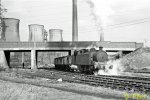
No.13 RSH 7846/55 passes under one of the sites internal roads with three of B Station's four cooling towers in the background.
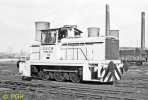
The first new diesel - No.1D a 500hp 0-6-0DH built by English Electric at their Vulcan Works, Newton-le-Willows, works No.D1137 in 1966. Two more similar locos were supplied in 1967. 1D was sold to Ribblesdale Cement Ltd., Clitheroe, in 1985.
WD 883 an 0-6-0DE built by Armstrong Whitworth works No.D58 in 1935 as LMSR No.7063. It was transferred to the War Department initially on loan but later sold to the WD when it was renumbered 70216. According to Tourret in "War Department Locomotives" (1976) it was one of the nine diesel locomotives (6 ex LMS, 3 ex SR) used on the Martin Mill Military Railway which served two large naval guns on the cliffs at St. Margaret's Bay near Dover. Diesel locos were preferred on this line as steam might have given the position of the guns away from the other side of the channel. Apparently it was named "Flying Scotsman" while on the MMMR. After the war 70216 worked at various depots, being renumbered 883 in 1952 and transferred to the Cairnryan Military Railway near Stranraer. It was moved to the Bicester Workshops at Arncott in October 1955 and then used on the Bicester Military Railway where it received the name ROYAL ENGINEER in 1959. In August 1963 it was sold to the dealer E.L.Pitt & Co. (Coventry) Ltd. who had a yard adjacent to Brackley Town Station. In February 1966 it was loaned or hired to the CEGB at Hams Hall, possibly to test the suitability of diesel locos before they acquired new locomotives. After this the dealer apparently had no further use for the loco and it was later cut up on site at Hams Hall.
From 1" Ordnance Survey. The track layout incorporated a long reverse loop passing B and C Stations. Loco sheds were provided at A and C Stations.
The photos were taken on a visit in March 1967 just after the arrival of the first of three new diesel locos.
Peckett Class W6 0-4-0STs No.4 (1738 of 1928) and No.3 (1736 of 1927), supplied new for the opening of the A Station. No.4 went for preservation to the Severn Valley Railway in July 1968, and saw some use for shunting at Bridgnorth Station. After long periods of little use on the SVR it moved to the South Devon Railway in 1995, and its now on the private line at Titley Junction in Herefordshire. No.3 was scrapped in 1968.
No.5 Hawthorn Leslie works No.3904 of supplied new in December 1936 to the City of Birmingham Electric Supply Department as indicated by the initials on its number plate. This was the first of a series of eight large 18" cylinder 0-6-0Ts supplied to Hams Hall by Hawthorn Leslie and its successor Robert Stephenson & Hawthorns. No.5 was scrapped in 1968 after the diesel locos took over most of the work.
No.9 Robert Stephenson & Hawthorns works No.7151 supplied to Hams Hall in December 1944. It was sold to the Bristol Suburban Railway Society at Bitton Station in February 1981, the line now operating as the Avon Valley Railway.
No.10 Robert Stephenson & Hawthorns works No.7536 supplied in March 1949. By that date the power stations were controlled by the British Electricity Authority Midlands Division and the tank sides are lettered accordingly. It was scrapped in 1968.
No.13 Robert Stephenson & Hawthorns works No.7846 supplied in October 1955 and lettered for the Central Electricity Authority Midlands Division. It was sold for preservation to the Stour Valley Railway and initially moved to Rye House Power Station in August 1974 for storage before arriving at Chappel & Wakes Colne Station. However no work was carried out on it there and in June 1982 the loco was purchased by the North Downs Steam Railway (NDSR) and moved to Higham in Kent. Some work was carried out on it at the Chatham Naval Dockyard, after which it was moved to the NDSR's new location at Dartford for completion of the restoration and named NORTH DOWNS. In 1996 the NDSR merged with the Tunbridge Wells & Eridge Railway Preservation Society (TWERPS) to form the Spa Valley Railway and the loco was the first to operate on the railway at Tunbridge Wells West. It was taken out of service in October 1997 needing firebox repairs. In January 2016 it was put up for sale in a dismantled condition and sold to the Ferryhill Railway Heritage Trust whose aim is to restore the former BR Ferryhill Loco Shed at Aberdeen into a working railway heritage site. Work is under way to restore it to operational condition.
No.5 HL 3904/36 outside the 4 road loco shed at A Station, with the cooling towers of B Station in the right distance. Parachute type water tanks are not particularly common on industrial railway systems.

No.13 RSH 7846/55 passes under one of the sites internal roads with three of B Station's four cooling towers in the background.

The first new diesel - No.1D a 500hp 0-6-0DH built by English Electric at their Vulcan Works, Newton-le-Willows, works No.D1137 in 1966. Two more similar locos were supplied in 1967. 1D was sold to Ribblesdale Cement Ltd., Clitheroe, in 1985.
WD 883 an 0-6-0DE built by Armstrong Whitworth works No.D58 in 1935 as LMSR No.7063. It was transferred to the War Department initially on loan but later sold to the WD when it was renumbered 70216. According to Tourret in "War Department Locomotives" (1976) it was one of the nine diesel locomotives (6 ex LMS, 3 ex SR) used on the Martin Mill Military Railway which served two large naval guns on the cliffs at St. Margaret's Bay near Dover. Diesel locos were preferred on this line as steam might have given the position of the guns away from the other side of the channel. Apparently it was named "Flying Scotsman" while on the MMMR. After the war 70216 worked at various depots, being renumbered 883 in 1952 and transferred to the Cairnryan Military Railway near Stranraer. It was moved to the Bicester Workshops at Arncott in October 1955 and then used on the Bicester Military Railway where it received the name ROYAL ENGINEER in 1959. In August 1963 it was sold to the dealer E.L.Pitt & Co. (Coventry) Ltd. who had a yard adjacent to Brackley Town Station. In February 1966 it was loaned or hired to the CEGB at Hams Hall, possibly to test the suitability of diesel locos before they acquired new locomotives. After this the dealer apparently had no further use for the loco and it was later cut up on site at Hams Hall.
Osgood
Western Thunderer
As an aside (let me know you'd like this post removed and posted elsewhere Phil), I've been trying to find out more about EL Pitt & Co. - who I have always considered primarily to be major railway track dismantlers and resellers.
I have a chair cast with the name PITTRAIL - is it reasonable to assume this is the same company?
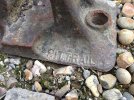
It seems odd that a company so heavily involved with reselling track components would need to source new chairs - unless of course they were installers of private sidings etc in the days before the Beeching era, when lines were lifted on such a huge scale?
I have a chair cast with the name PITTRAIL - is it reasonable to assume this is the same company?

It seems odd that a company so heavily involved with reselling track components would need to source new chairs - unless of course they were installers of private sidings etc in the days before the Beeching era, when lines were lifted on such a huge scale?

